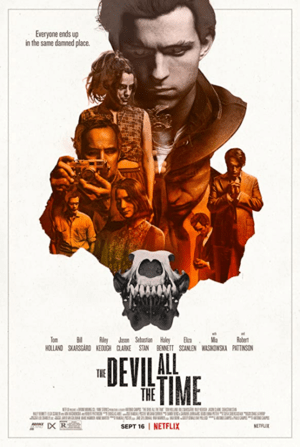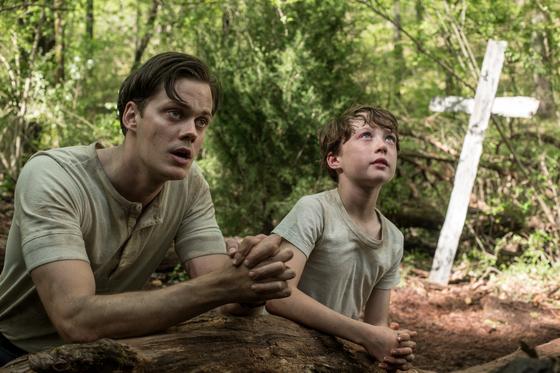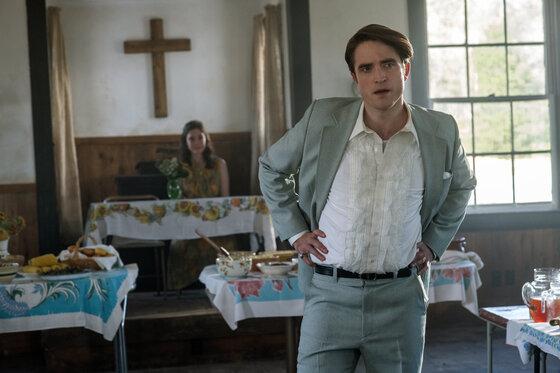
Director Antonio Campos held a Q&A with reporters ahead of the release of his latest film, The Devil All The Time. Scene-Stealers was able to take part in the roundtable discussion and learned more about the filmmaking process that went into the period drama that stars Tom Holland and Robert Pattinson.
Here’s what was discussed:
You worked closely with the author Donald Ray Pollack on the adaptation. Was there any specific changes from the novel that you fought to bring your vision to life?
Campos: Well, what I’ll tell you what really kind of, I think, it turned into my favorite scene of the movie is in the end, there’s a confrontation that happens between Arvin, Tom Holland‘s character and Rob Pattinson plays Teagardin, and in the book, it happens in this remote little corner where Teagardin takes his victims, and we, we switched it into the church and we changed the dynamics so that you almost start the scene off as though this young guy has come in to confess to this preacher, and then you realize that the intention is way more dangerous than that. And so, you know, that was one example of how we took a note from Don and then just played with it and sort of kept the essence of the scene the same, but just kind of made it a little bit more dynamic and cinematic in a way.

What are your thoughts on Bill Skarsgård’s comments that the film is not necessarily a comment on religion, as much as it’s a comment on what people do with religion?
Campos: I mean, I think that’s beautifully articulated by Bill, who is such a wise, wonderful soul. You know, it really is about extreme believers in religion in their faith, and the dangers of that because, you know, all these characters are screaming to the heavens looking for answers and what they get in return is silence and in that void, they fill it with an answer themselves. And it is a person who is traumatized or delusional, they can fill it with a dangerous answer. And so, the film is exploring the dangers of extreme religion and how people in power can take advantage of people’s faith and manipulate them. That’s what we’re exploring. The film isn’t anti-religion. It is it is more comment on the dangers of religion in the wrong hands.
In terms of the adaptation process, both juggling all those characters throughout, but also introducing them in a way that doesn’t overwhelm the viewer. That has to be a challenge?
Campos: It’s definitely a challenge, juggling this many characters. What we have to do with this movie was to sort of like, introduce characters in the periphery and let them be known by the audience, so that when they come back, you’re like ready to go with them. And that’s kind of why you have to cast some of these actors with recognizable faces. Because if you go and you’re like, oh, that’s Jason Clarke, oh, that’s Riley Keough, you go, they’re going to be in this movie again. There’s just something subconsciously that’s happening when you’re watching that go down. So, without doing very much, you’re like, oh, that’s a character that’s gonna be part of the movie. And then, when they come back, you’re like, ready for it. So, it’s about how do you kind of like pepper the other characters in before their story lines sort of take over. And then also making sure you cast them with someone that’s either going to be memorable or someone that you are familiar with, that you know is going to come back.
It felt like Robert Pattinson just kind of took it up another notch, like a like a step above everyone else. Was that a choice you guys made together, or was that all him?
Campos: We always wanted Teagardin to have like this other worldly quality, like a big entrance, like he’s designed to come into the movie and shake it up. Like when Teagardin comes in, you’re just like, you know you’re settling into this other storyline. You’re getting to know Tom Holland’s character and Eliza Scanlen’s character. And then you’re like, what’s gonna happen? Where is the danger? Where’s the danger and then Teagardin shows up. So, we always knew that Teagardin kind of was like this force, that kind of shape who picks up the rest of the movie. And because he’s from so far outside the realm of the the movie, like so far outside of West Virginia and Ohio, he had, he had so much freedom to kind of like just run with that character and go. And I really was like, just go as just go as far as you want to go, like just swinging for the fences. And if I ever had, like, if I have to rein it in, we will, but like, I just love performances like that. And that was really sort of the mandate across the board. I think everybody in this film pushes themselves into places that they might not have gone before. Like, I think Sebastian Stan’s Bodecker is like, it’s just amazing. I mean, he’s doing stuff that is just kind of like that is swinging for the fences and he transforms his body and everything and says, so everybody was kind of like just that. I tried to do give everybody a sense of freedom to go and have fun with their characters.

QWhat scene were you the most proud to do that you were like, man, I really flexed all of my talent and hard work and everything?
Campos: Simple. For me. It’s this one scene that I just think is like my favorite, one of my favorite things I’ve ever directed, which is the face off in the church between Tom and Rob. From the moment that we wrote it to just every step of the way of shooting it, of directing the actors, because it was like theater. You know, it’s just two people sitting there looking at each other, having a conversation making something that we designed. You know, when you have these kind of very simple setups, you really kind of spend so much time designing it. So that every shot, every moment, just kind of feels really rich. And then in that scene, my wife is the editor and we worked on that in some way. Like every day for eight months, like I, I went to bed thinking about that scene, I woke up thinking about that scene. It was like this obsession. And then in the sound mix, we were like obsessed with every detail of them sitting with the sound of the chair, their clothes, the rattle the gun, and then the score. Just really nailing the score the kind of ride the music takes you on through that scene. So that is the scene that is like, I think the most complex in terms of its design, and in some ways, the simplest in terms of its setup. So, I really, I really love that scene, and I think that’ll be one of my favorite scenes that I’ve ever made or been part of making.





Comments on this entry are closed.